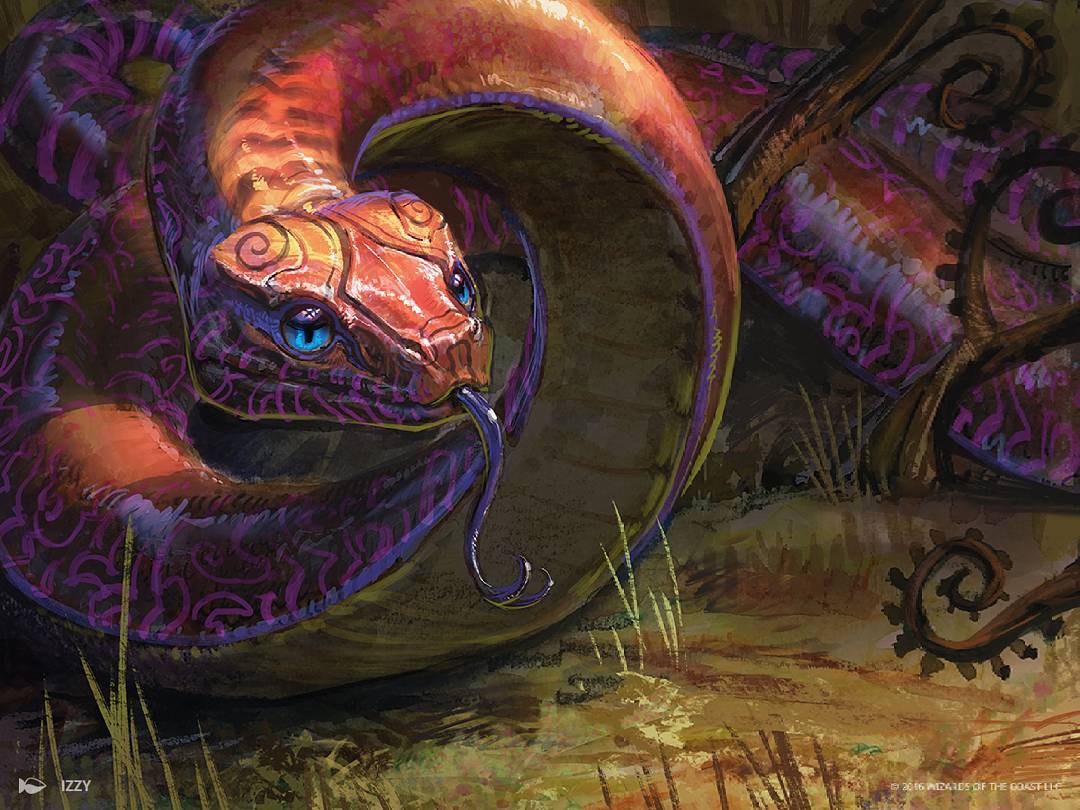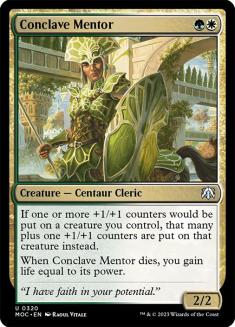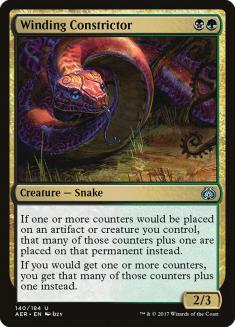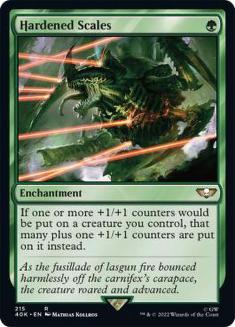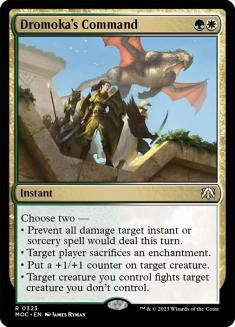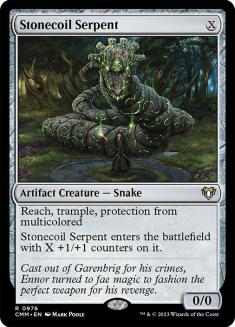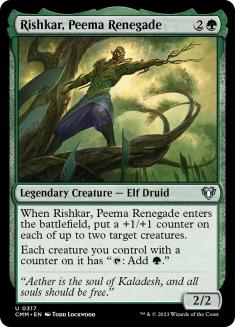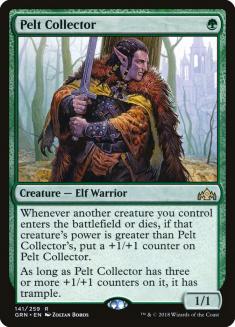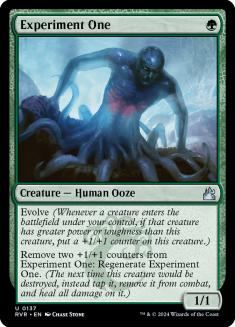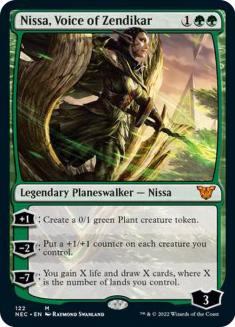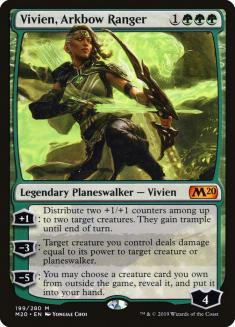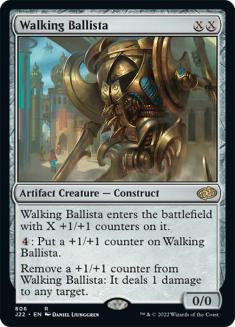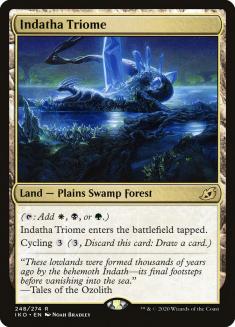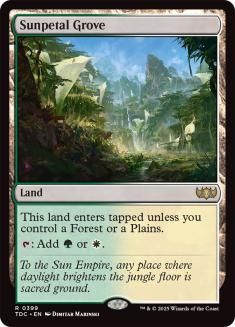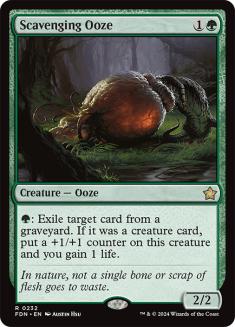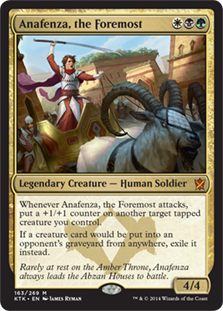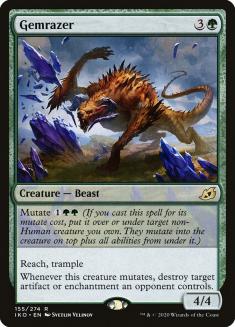This week’s article will be focusing entirely on the Hardened Scales archetype in Pioneer. Core Set 2021 brought with it a new tool to utilize in the deck, giving you access to more virtual copies of Hardened Scales. Since Hardened Scales is the best card in the deck, I feel like having more copies is a pretty good thing!
There’s quite a bit to say about this card in general, but the fact of the matter is that it’s just a Selesnya version of Winding Constrictor. How you use that information is completely up to you. I’d like to try a few different iterations, but let’s talk about the first one I came up with.
My first inclination was to pair Conclave Mentor with Huatli’s Raptor. Adding that creature suite to Selesnya Scales gives you a nice replacement for Winding Constrictor. The manabase for a two-color deck is desirable, as you take less damage against the aggressive decks. Having a functional replacement for Winding Constrictor seems great!
However, after analyzing the mana available for use, it felt like playing a third color was mostly painless. Because we don’t have Brushland or Razorverge Thicket, and most of the other options enter the battlefield tapped, adding black for Winding Constrictor had virtually no cost because I already wanted to play four copies of Mana Confluence.
After a lot of consideration, here is the list I ended up testing in my first go.
Creatures (26)
- 4 Experiment One
- 4 Winding Constrictor
- 2 Rishkar, Peema Renegade
- 4 Walking Ballista
- 4 Pelt Collector
- 4 Stonecoil Serpent
- 4 Conclave Mentor
Planeswalkers (6)
Lands (20)
Spells (8)
Sideboard

There are multiple ways to build this deck, including going hard on Llanowar Elves and such, but I wanted to be much more aggressive to punish the combo decks. Creatures being good on their own, and even decent against Supreme Verdict, was a priority for me. In this initial build, I went with the more aggressive slant of Experiment One and Pelt Collector as the synergy with both Winding Constrictor and Conclave Mentor to immediately become a 3/3 was a tad absurd at times.
This is the true draw of the deck. These three cards work well in multiples, but a single iteration gives your deck the strength and speed it needs to compete with all forms of combo. If left unfettered, you can kill most opponents on the fourth turn while goldfishing. After sideboard, you have that same speed, but get to replace some of your “longevity” cards like Vivien, Arkbow Ranger with Thoughtseize or Fatal Push.
These three similar cards allow you to generate an absurd advantage with very few resources. One copy by itself will usually allow Pelt Collector or Experiment One to become Wild Nacatl, but additional copies will create a battlefield that quickly gets out of hand. Imagine curving into Nissa, Voice of Zendikar after sticking a Winding Constrictor and Conclave Mentor. Most of us who’ve played Pioneer have battled against Winding Constrictor doing this type of thing before, but having four additional versions of the same effect increases your consistency by a lot. The fact that it’s a creature instead of an enchantment also means it can directly benefit from those pump effects.
Hardened Scales has long been one of my favorite archetypes in Pioneer. The addition of Conclave Mentor means we get to try out some new stuff, and I’m excited to see exactly what it can do. It’s not often you get a deck where every additional version of the same effect adds to the power of your draw instead of creating a weakness inside your redundancy. Having all your effects compound in strength as opposed to becoming weaker is one of the true underlying strengths of the Hardened Scales archetype.
This one really got the creative juices flowing because it reminded me of all the matches I’d played with Bant Heroic in Standard’s past. When paired with Hardened Scales or pump creatures, you get to add an extra counter, which in turn helps you win more fights with the second ability. On occasion, you get to snipe an enchantment or prevent a Lightning Strike from killing one of your creatures, but the two modes you use most often are “counter and fight.”
Dromoka’s Command is a removal spell that functions as a way to pump your creatures in a significant way. It’s not great against combo or control, but what removal spells are? At the very least, you get to have a backdoor answer to Silkwrap or whatever. It gets sideboarded out often, but that variability in usage gives it some high marks.
I’m not a huge fan of how Dromoka’s Command interacts (or doesn’t) with Stonecoil Serpent, but initial testing found Stonecoil Serpent to be the perfect draw at nearly every point in every game. Alongside all the pump effects, you get to a very large creature that has protection from quite a few things and evasion. It allows you to use all of your mana every single turn, which ultimately leads to an increasing advantage over time. Generally speaking, the person who uses the most mana each game usually becomes the winner, so X-spells that function well at multiple intervals are integral to decks like Hardened Scales.
Stonecoil Serpent has become a staple in many of these archetypes. Even though it looks bad on paper, it plays out quite nicely and I very much enjoy having access to Stonecoil Serpent in Hardened Scales. Most of the abilities come in handy throughout a five-match set and it’s one of the easiest ways to gain a payoff for your Hardened Scales-type cards.
Moving forward, I’m likely to trim Dromoka’s Command because that “non-bo” came up twice in five matches and I’ve found Stonecoil Serpent to be so good. Depending on how the format shifts over time, it might be correct to play Dromoka’s Command anyway, or potentially instead of Stonecoil Serpent.
Rishkar, Peema Renegade is not good when you’re playing Llanowar Elves and Elvish Mystic, which was the go-to version of this deck when Once Upon a Time was still in the format. The bodies on both Elves made Nissa, Voice of Zendikar a little bit better while giving you access to some bursts of speed, but the fact of the matter is that they’re just not great unless you have more widespread pump effects. If you have eight Elves, twelve pump cards, and only six or eight ways to pump those Elves, you’ll often find yourself flooding out.
Rishkar, Peema Renegade is really weak alongside the Elves, yet is quite strong when you can pivot to using mana you previously didn’t have access to, or are just more aggressively slanted. The same is true for something like Venerated Loxodon and convoke, as having your creatures already tap for mana makes the ability much weaker.
Rishkar, Peema Renegade gets sideboarded out quite a lot, but it’s stellar on the play and provides for some very one-sided games. It helps bail you out by giving you a lot of pressure and an extra body when you miss your one-drop. If drawn later in the game, it can generate quite a lot of mana to pump the hell out of a Walking Ballista. It has a lot of uses, but regularly gets overshadowed by how bad it is when facing down sweeper effects like Ritual of Soot or Supreme Verdict.
Both of these creatures pair nicely with the twelve Hardened Scales effects. They also make Stonecoil Serpent significantly better, as it’s not very hard to make it bigger than these two little creatures. These creatures give your deck the aggressive slant you need to compete in such a hostile format. When everyone is playing combo, having an aggressive slant to your deck is important because it allows you to steal games where the combo decks falter.
This dynamic duo was really impressive in the first run with the archetype, giving me some serious “old-school Pioneer” vibes. When building a new archetype, or trying to improve on an old one, it’s important to understand how the deck “feels.” This list felt pretty great, which is itself impressive for a first run. The only thing that felt bad was the interaction between Dromoka’s Command and Stonecoil Serpent. Everything else was right on the money.
As always, Nissa, Voice of Zendikar is one of the most impressive cards in this archetype. It generates bodies for itself but singlehandedly makes all of your counter-related cards much better. In this iteration without Llanowar Elves or Elvish Mystic, it’s a little slower, but it comes in clutch at just the right times. Against Rotting Regisaur and company, it can generate some blockers while you gain a foothold. Against just about everything else, you get a swarm of small creatures up to Overrun levels.
There should be no question that Nissa, Voice of Zendikar is the major reason why this archetype flourishes. Without it, I doubt it would be remotely as powerful. Draws featuring Nissa, Voice of Zendikar and those without are drastically different. It’s like playing on easy mode. The same used to be true for Hardened Scales, but it’s much more likely you start with one of those twelve effects since you only have four copies of Nissa, Voice of Zendikar.
Vivien, Arkbow Ranger gives you some staying power against control, but it’s just a proactive and versatile card with a lot of uses. Biting an opposing creature or pumping your squad is quite strong, but the occasional tutor for Gemrazer out of the sideboard can’t be overlooked.
Vivien does get sideboarded out a lot, but that’s because it’s much worse on the draw, and also a bit slower than I’m used to because I’m not playing Llanowar Elves anymore. I’m not putting a huge emphasis on it because I don’t think it’s needed, but it’s worth trying out for sure. So far, testing has been inconclusive, but I do know it’s much worse in this version than the ones that play Llanowar Elves.
The best payoff in the deck, Walking Ballista gives you access to an effect that your color combination doesn’t usually have. You can put some mad counters on Walking Ballista in this archetype, giving you a huge advantage against other creature-based strategies. Not only are your creatures bigger on average, but yours are also interactive. Walking Ballista chopping down an opposing Llanowar Elves in the early turns is just icing on the cake.
If you play this deck, you want four copies of Walking Ballista, full stop.
It is not a mistake or accident that we have more black sources than white sources, even though we technically have more white cards in our deck. Splashing black is easy, whereas splashing white means lands enter the battlefield tapped. Both Sunpetal Grove and Indatha Triome help hit your colors, but will regularly lead to some awkward starts. Mana Confluence can only help so much!
I don’t know if this is the best manabase in the world, but it was functional and felt fine on my first playthrough. I’ll likely be tweaking the numbers at some point in the future.
The Sideboard
This is obviously one of your better tools for interacting with aggressive opponents. At the moment, Fatal Push is the most efficient answer to an opposing one- or two-mana creature, yet has some value if they get a little more expensive as the game progresses. You have multiple “zero”-mana creatures that can be killed off to make Fatal Push better, including burning the last counter on Walking Ballista. I don’t need to tell you how important it is to have access to this card, but I would like to stress that the current metagame does not call for playing it in the maindeck.
Fatal Push isn’t often a sideboard card, but it’s much worse right now than it should be because the format is so combo-oriented. This deck also wants ton of creatures that play the same role as traditional removal. With so many enablers and payoffs, you can’t really afford to have slots in the maindeck that aren’t dedicated to your overall gameplan of “generating a ton of large creatures.”
Thoughtseize is definitely a card I could see playing in the maindeck of Abzan Scales. I just don’t know how many or if it’s actually necessary. Your aggression in the first game will steal a lot of games against combo, but your post-sideboard configuration could and probably should have access to some cheap discard to fight that Dimir Inverter nonsense.
This is one of the best creatures in Pioneer for this archetype against an opposing red deck, but it has a lot of value against Sultai Midrange or other graveyard-related archetypes. It’s probably good enough to see some maindeck play, but I just couldn’t find room in the initial version.
This one likely isn’t good enough, but I thought the ability to be cool and the anti-graveyard effect to be desirable. There are a few creature-based graveyard decks running around, so giving Scavenging Ooze a little help while staying on theme felt interesting enough to try. In actuality, the effects were too slow on both sides of the coin. I won’t be playing this in the future, but I did think it was worth mentioning because it was in my initial build.
This is a hot one that doesn’t really need an introduction. It’s been sick in Standard with Stonecoil Serpent, and it’s just as good here. Reclamation Sage used to have that slot in this archetype, but Gemrazer just hits so much harder.
The Future of Abzan Scales in Pioneer
I’d like to try out a few more iterations before I move on to my next project, but Abzan Scales felt great. I’m very much looking forward to seeing if there are any innovations we could try next. Cards like Huatli’s Raptor and The First Iroan Games have seen play in other builds. I’d like to try a “go wide” version soon that features Venerated Loxodon. The truth of the matter is that I don’t rightly know exactly what the best build is yet because I just started dipping my toes back into the archetype!
To be frank, I’m really disappointed with the lack of action in Pioneer as far as banning anything out of the combo decks is concerned. I don’t want to get into it too much because I’ve spent the last two days being incredibly upset. I just hope they come to their senses soon and get rid of some of these combo decks that are smothering the format. I can only play against Lotus Breach and Dimir Inverter and Mono-White Devotion and Kethis Combo so many times before I just start conceding the match when they play their first land.
I’ll keep trying out new stuff, as well as expanding on existing archetypes with new cards, but there is definitely some serious combo fatigue, and I don’t think I’m alone. The reaction to the most recent Pioneer bannings was overwhelmingly negative, and it seems like the excitement for the format has mostly vanished over the last six months since Theros Beyond Death was released. Turns out playing games that end in a combo flourish is anticlimactic, and there’s already been quite a precedent set for two-card combos in the Pioneer format.

